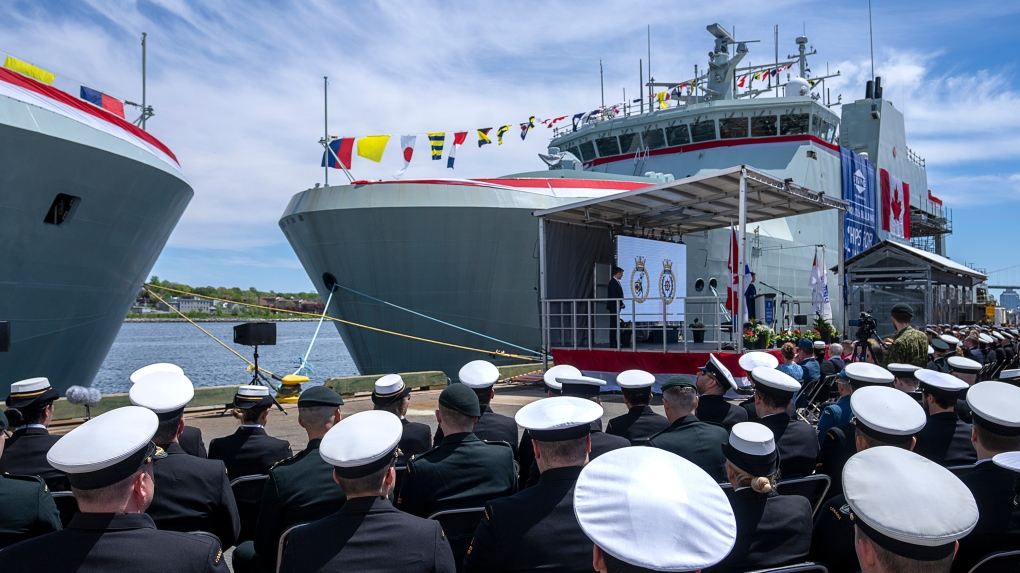Canadian navy's Pacific fleet to accept first Arctic patrol vessel
 Members of the Royal Canadian Navy attend a naming ceremony for HMCS Margaret Brooke and HMCS Max Bernays, Arctic and Offshore Patrol Ships (AOPS) at Halifax Shipyards in Halifax on Sunday, May 29, 2022. THE CANADIAN PRESS/Andrew Vaughan
Members of the Royal Canadian Navy attend a naming ceremony for HMCS Margaret Brooke and HMCS Max Bernays, Arctic and Offshore Patrol Ships (AOPS) at Halifax Shipyards in Halifax on Sunday, May 29, 2022. THE CANADIAN PRESS/Andrew Vaughan
The Canadian navy's Pacific fleet is set to take possession of its first Arctic patrol vessel, which arrives in British Columbia next week ahead of a formal commissioning ceremony.
HMCS Max Bernays is the third Arctic patrol ship built for the Royal Canadian Navy, which has ordered six of the vessels to conduct surveillance and assert sovereignty over territorial waters, including in the Far North.
The ship, which left Halifax last month and transited the Panama Canal before making port visits in California, is scheduled to arrive at its home port in Esquimalt, B.C., on Monday.
Following a commissioning ceremony in North Vancouver on May 3, the new vessel will immediately undergo maintenance work, according to the Department of National Defence, which expects the vessel to be ready to participate in the biannual Exercise Rim of the Pacific (RIMPAC), the world's largest multinational naval exercise, off Hawaii this summer.
Ships not ready for helicopter operations
While the Arctic patrol vessels were designed to accommodate the CH-148 Cyclone, the military's main maritime helicopter, that capability likely won't be realized for years to come.
National Defence spokesperson Kened Sadiku said plans are underway to "support and deliver initial air operations capabilities during the RIMPAC exercise this summer," however the military could not confirm whether that would involve an embarked Cyclone, a different aircraft, or neither.
"The Canadian Armed Forces won't be commenting on any personnel or assets committed to RIMPAC 24 ahead of the official announcement of the exercise, which is expected to come sometime later this spring," he added.
The spokesperson said the military is working to integrate the Arctic patrol vessels with the maritime helicopters by 2027 or 2028. "The capability to fully operate a CH-148 Cyclone Helicopter will be achieved in phased delivery timelines," Sadiku added.
In a separate email on Friday, National Defence spokesperson Andrée-Anne Poulin said that while the new Arctic patrol vessels were "generally configured to operate with a helicopter, they are not yet ready to do so permanently."
The vessels will require several installations and modifications "before the ship would be considered compliant for air operations" with the Cyclone or lighter aircraft, according to Poulin. "No specific dates can be provided at this time," she added.
Following the RIMPAC exercise, the Pacific fleet's newest ship is expected to patrol the western High Arctic during Operation Nanook, the Canadian Armed Forces' primary northern exercise, in the fall.
CTVNews.ca Top Stories

opinion Tom Mulcair: Prime Minister Justin Trudeau's train wreck of a final act
In his latest column for CTVNews.ca, former NDP leader and political analyst Tom Mulcair puts a spotlight on the 'spectacular failure' of Prime Minister Justin Trudeau's final act on the political stage.
B.C. mayor gets calls from across Canada about 'crazy' plan to recruit doctors
A British Columbia community's "out-of-the-box" plan to ease its family doctor shortage by hiring physicians as city employees is sparking interest from across Canada, says Colwood Mayor Doug Kobayashi.
'There’s no support': Domestic abuse survivor shares difficulties leaving her relationship
An Edmonton woman who tried to flee an abusive relationship ended up back where she started in part due to a lack of shelter space.
opinion King Charles' Christmas: Who's in and who's out this year?
Christmas 2024 is set to be a Christmas like no other for the Royal Family, says royal commentator Afua Hagan. King Charles III has initiated the most important and significant transformation of royal Christmas celebrations in decades.
Baseball Hall of Famer Rickey Henderson dead at 65, reports say
Rickey Henderson, a Baseball Hall of Famer and Major League Baseball’s all-time stolen bases leader, is dead at 65, according to multiple reports.
Arizona third-grader saves choking friend
An Arizona third-grader is being recognized by his local fire department after saving a friend from choking.
Germans mourn the 5 killed and 200 injured in the apparent attack on a Christmas market
Germans on Saturday mourned the victims of an apparent attack in which authorities say a doctor drove into a busy outdoor Christmas market, killing five people, injuring 200 others and shaking the public’s sense of security at what would otherwise be a time of joy.
Blake Lively accuses 'It Ends With Us' director Justin Baldoni of harassment and smear campaign
Blake Lively has accused her 'It Ends With Us' director and co-star Justin Baldoni of sexual harassment on the set of the movie and a subsequent effort to “destroy' her reputation in a legal complaint.
Oysters distributed in B.C., Alberta, Ontario recalled for norovirus contamination
The Canadian Food Inspection Agency has issued a recall due to possible norovirus contamination of certain oysters distributed in British Columbia, Alberta and Ontario.

































